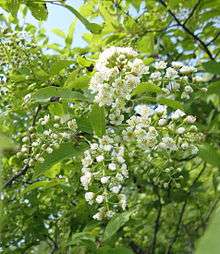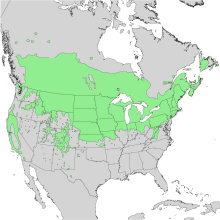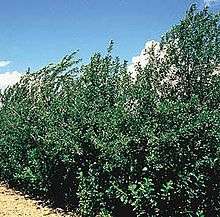Prunus virginiana
Prunus virginiana, commonly called bitter-berry,[3] chokecherry,[3] Virginia bird cherry[3] and western chokecherry[3] (also black chokecherry for P. virginiana var. demissa[3]), is a species of bird cherry (Prunus subgenus Padus) native to North America; the natural historic range of P. virginiana includes most of Canada (including Northwest Territories but excluding Yukon, Nunavut, and Labrador), most of the United States (including Alaska but excluding some states in the Southeast) and northern Mexico (Sonora, Chihuahua, Baja California, Durango, Zacatecas, Coahuila and Nuevo León).[4][5][6]
| Prunus virginiana | |
|---|---|
 | |
| Prunus virginiana var. virginiana (eastern chokecherry) in bloom | |
| Scientific classification | |
| Kingdom: | Plantae |
| Clade: | Tracheophytes |
| Clade: | Angiosperms |
| Clade: | Eudicots |
| Clade: | Rosids |
| Order: | Rosales |
| Family: | Rosaceae |
| Genus: | Prunus |
| Subgenus: | |
| Species: | P. virginiana |
| Binomial name | |
| Prunus virginiana | |
 | |
| Natural range | |
| Synonyms[2] | |
|
List
| |
Description
Chokecherry is a suckering shrub or small tree growing to 1–6 m (3 ft 3 in–19 ft 8 in) tall, rarely to 10 m (32 ft 10 in). The leaves are oval, 2.5–9 cm (1–3 1⁄2 in) long and 1.2–5 cm (1⁄2–2 in) wide, with a serrated margin.[6]
The flowers are produced in racemes 4–11 cm (1 1⁄2–4 1⁄4 in) long in late spring (well after leaf emergence). They are 1⁄3–1⁄2 in (8–13 mm) across.[7][8]
The fruits (drupes) are about 6–14 mm (1⁄4–9⁄16 in) in diameter, range in color from bright red to black, and possess a very astringent taste, being both somewhat sour and somewhat bitter. They get darker and marginally sweeter as they ripen.[6]
Characteristics
Chokecherries are very high in antioxidant pigment compounds, such as anthocyanins. They share this property with chokeberries, further contributing to confusion.[6]
- Prunus virginiana var. virginiana (the eastern chokecherry)
- Prunus virginiana var. demissa (Nutt. ex Torr. & A.Gray) Torr. (the western chokecherry)
- Prunus virginiana var. melanocarpa (A.Nelson) Sarg.

The wild chokecherry is often considered a pest, as it is a host for the tent caterpillar, a threat to other fruit plants. However, there are more appreciated cultivars of the chokecherry. 'Canada Red' or 'Schubert' has leaves that mature to purple and turn orange and red in the autumn.[10] 'Goertz' has a nonastringent, and therefore palatable, fruit. Research at the University of Saskatchewan seeks to find and create new cultivars to increase production and processing.
The chokecherry is closely related to the black cherry (Prunus serotina) of eastern North America; it is most readily distinguished from that by its smaller size (black cherry trees can reach 100 feet tall), smaller leaves, and sometimes red ripe fruit. The chokecherry leaf has a finely serrated margin and is dark green above with a paler underside, while the black cherry leaf has numerous blunt edges along its margin and is dark green and smooth.[6][11]
The name chokecherry is also used for the related Manchurian cherry or Amur chokecherry (Prunus maackii).
Food use
For many Native American tribes of the Northern Rockies, Northern Plains, and boreal forest region of Canada and the United States, chokecherries are the most important fruit in their traditional diets and are part of pemmican, a staple traditional food. The bark of chokecherry root is made into an asperous-textured concoction used to ward off or treat colds, fever and stomach maladies by Native Americans.[12] The inner bark of the chokecherry, as well as red osier dogwood, or alder, is also used by some tribes in ceremonial smoking mixtures, known as kinnikinnick.[13] The chokecherry fruit can be used to make jam or syrup, but the bitter nature of the fruit requires sugar to sweeten the preserves.[14] Sacagawea was eating choke cherries when she was discovered by Lewis and Clark. The Plains Indians pound up the whole fruits—including the toxic pits—into a mortar, from which they made sun-baked cakes.[15]
The stone of the fruit is poisonous.[16] Chokecherry is toxic to horses, moose, cattle, goats, deer, and other animals with segmented stomachs (rumens), especially after the leaves have wilted (such as after a frost or after branches have been broken) because wilting releases cyanide and makes the plant sweet. About 10–20 lbs of foliage can be fatal. Symptoms of a horse that has been poisoned include heavy breathing, agitation, and weakness. The leaves of the chokecherry serve as food for caterpillars of various Lepidoptera. See List of Lepidoptera which feed on Prunus.
In 2007, Governor John Hoeven signed a bill naming the chokecherry the official fruit of the state of North Dakota, in part because its remains have been found at more archeological sites in the Dakotas than anywhere else.[17]
Chokecherry is also used to craft wine in the western United States, mainly in the Dakotas and Utah, as well as in Manitoba, Canada.
Ecology
It is a larval host to the black-waved flannel moth, the blinded sphinx, the cecropia moth, the coral hairstreak, the cynthia moth, the elm sphinx, the Glover's silkmoth, the hummingbird clearwing moth, the imperial moth, the Io moth, the polyphemus moth, the promethea moth, the red-spotted purple, the small-eyed sphinx, the spring azure, the striped hairstreak, the tiger swallowtail, the twin-spotted sphinx, and the Weidemeyer's admiral. [18]
See also
References
- Rehder, A. (1977) [1940]. Manual of cultivated trees and shrubs hardy in North America exclusive of the subtropical and warmer temperate regions. New York: Macmillan.
- "Prunus virginiana". Richard Pankhurst et al. Royal Botanic Gardens Edinburgh. Retrieved January 27, 2014 – via The Plant List.CS1 maint: others (link)
- "Prunus virginiana". Germplasm Resources Information Network (GRIN). Agricultural Research Service (ARS), United States Department of Agriculture (USDA). Retrieved February 28, 2013.
- "Prunus virginiana". State-level distribution map from the North American Plant Atlas (NAPA). Biota of North America Program (BONAP). 2014.
- "Prunus virginiana: photos, partial distribution map". SEINet, Arizona–New Mexico chapter.
- Rohrer, Joseph R. (2014). "Prunus virginiana". In Flora of North America Editorial Committee (ed.). Flora of North America North of Mexico (FNA). 9. New York and Oxford – via eFloras.org, Missouri Botanical Garden, St. Louis, MO & Harvard University Herbaria, Cambridge, MA.
- Hilty, John (2016). "Chokecherry (Prunus virginiana)". Illinois Wildflowers.
- Chayka, Katy; Dziuk, Peter (2016). "Prunus virginiana (Chokecherry)". Minnesota Wildflowers.
- Farrar, J.L. (1995). Trees in Canada. Markham, Ontario: Fitzhenry & Whiteside.
- Michigan State University Extension and Michigan Nursery and Landscape Association (eds.). "Prunus virginiana--Chokecherry". Ornamental Plants plus Version 3.0. Michigan State University. Archived from the original on 2001-11-26.CS1 maint: uses editors parameter (link)
- Elias, Thomas S.; Dykeman, Peter A. (1990). Edible Wild Plants A North American Field Guide. New York: Sterling Publishing. ISBN 0-8069-7488-5.
- Smith, Norman F. (2002). Trees of Michigan and the Upper Great Lakes (6th ed.). Thunder Bay Press. p. 81.
- "Bearberry". Discovering Lewis and Clark. The Lewis and Clark Fort Mandan Foundation. 2009. Archived from the original on 2010-12-18. Retrieved 2011-04-29.
- Gibbons, Euell (1962). Stalking the Wild Asparagus. New York: David McKay.
- Peattie, Donald Culross (1953). A Natural History of Western Trees. New York: Bonanza Books. pp. 540–41.
- Whitney, Stephen (1985). Western Forests (The Audubon Society Nature Guides). New York: Knopf. p. 423. ISBN 0-394-73127-1.
- Kindscher, K. (1987). Edible Wild Plants of the Prairie: An Ethnobotanical Guide.
- The Xerces Society (2016), Gardening for Butterflies: How You Can Attract and Protect Beautiful, Beneficial Insects, Timber Press.
External links
| Wikimedia Commons has media related to Prunus virginiana. |